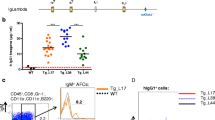Abstract
Purpose. During long-term treatment of various malignant or viral diseases with IFN-α up to 20% of patients develop anti-IFN-α antibodies for as yet unknown reasons.
Methods. To address this issue, a mouse model using Balb/C mice was established and the relevance of several potentially anti-IFN-α antibodies inducing factors was studied.
Results. The model revealed that both a higher frequency of injections and a higher dosage of IFN-α were more immunogenic and that the route of administration affected the antibody response to IFN-α. The intrinsic immunostimulatory activity of IFN-α itself also enhanced the immune response. IFN-α protein aggregates (IFN-α-IFN-α and human serum albumin (HSA)-IFN-α aggregates), which were recently identified in all marketed IFN-α products, were significantly more immunogenic than IFN-α monomers. These aggregates broke the tolerance against human IFN-α monomers in human IFN-α transgenic mice.
Conclusions. Based on these animal studies it is proposed that the immune response to IFN-α in humans is most probably elicited by a combination of several factors among which IFN-α protein aggregates seem to play a key role.
Similar content being viewed by others
REFERENCES
C. R. Kahn and A. S. Rosenthal. Diabetes Care 2:283-295 (1979).
J. Tyllström, B. Karlén, and O. Guilbaud. Proceedings of a Workshop: Immunological aspects of human growth hormone, pp. 19-32 (1985).
P. Roos, H. R. Fevold, and C. A. Gemzell. Biochemica et biophysica acta 74:525-531 (1963).
M. V. Manning, K. Patel, and R. T. Borchardt. Pharm Res 6:903-918 (1989).
M. W. Konrad, A. L. Childs, T. C. Merigan, and E. C. Borden. J Clin Immunol 7:365-375 (1987).
K. Bendtzen, M. B. Hansen, M. Diamant, C. Ross, and M. Svenson. Journal of Interferon Research, 14:157-158 (1994).
R. A. Figlin, and L. M. Itri. Semin Hematol 25:3 Suppl 3, 9-15 (1988).
M. M. Payne, and L. Leadbeater. J. Interferon Res. 11:Suppl., S263 (1991).
S. Pestka. Archives of Biochemistry and Biophysics 221:1-37 (1983).
C. M. Brand and L. Leadbeater. Journal of Interferon Research, 14:201-203 (1994).
K. U. Nolte, B. Schwartz, S. Pestka, and P. v. Wussow. Ann Hematol 66:Suppl 2, A103 (1993).
A. Palleroni, A. Aglione, M. Labow, M. Brunda, S. Pestka, F. Sinigaglia, G. Garotta, J. Alsenz, and A. Braun. J. Interferon Res. 14:Suppl. 1, S128 (1994).
X-Y. Liu, S. Maeda, K. Collier, and S. Pestka. Gene Anal. Techn. 2:83-88 (1985).
B. F. Hogan, F. Constantini, and E. Lacy. Cold Spring Harbor Laboratory, Cold Spring Harbor, NY (1986).
A. Braun and J. Alsenz. Pharm. Res. 14:1394-1400 (1997).
R. J. Wills, S. Dennis, H. E. Spiegel, D. M. Gibson, and P. I. Nadler. Clin. Pharmacol. Ther. 35:722-727 (1984).
M. Kälkner, H. Hagberg, and A. Karlsson Parra. Eur J Haematol 45:233-234 (1990).
W. J. Mayet, G. Hess, G. Gerken, S. Rossol, R. Voth, M. Manns, and K. H. Meyer zum Buschenfelde, Hepatology 10:24-28 (1989).
A. George, K. E. Shroff, S. Rath, S. N. Ghosh, S. R. Sengupta and R. S. Kamat. Microbiol. Immunol. 33:479-488 (1989).
M. Brenan and R. M. Zinkernagel. Infect. Immun. 41:470-475 (1983).
W. V. Moore and P. Leppert. J Clin Endocrinol Metab 51:691-697 (1980).
C. S. Henney and E. F. Ellis. The New England Journal of Medicine 278:1144-1146 (1968).
G. Steineck, H. Strander, and B-E. Carbin. Acta Oncologica 29:155-162 (1990).
Author information
Authors and Affiliations
Corresponding author
Rights and permissions
About this article
Cite this article
Braun, A., Kwee, L., Labow, M.A. et al. Protein Aggregates Seem to Play a Key Role Among the Parameters Influencing the Antigenicity of Interferon Alpha (IFN-α) in Normal and Transgenic Mice. Pharm Res 14, 1472–1478 (1997). https://doi.org/10.1023/A:1012193326789
Issue Date:
DOI: https://doi.org/10.1023/A:1012193326789



